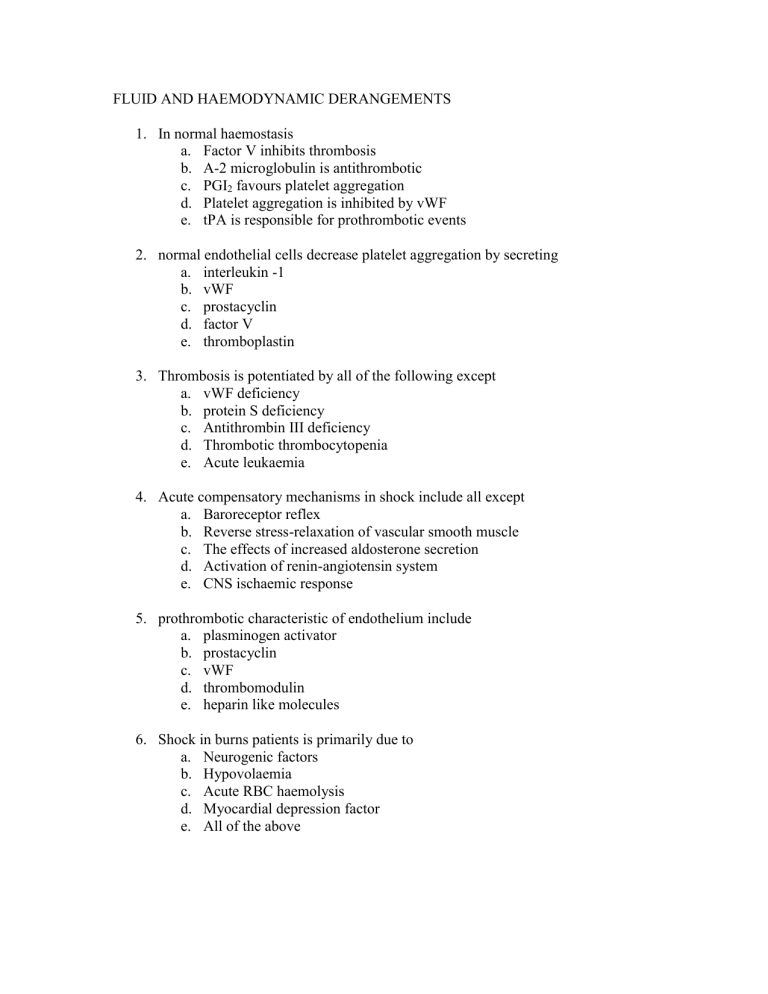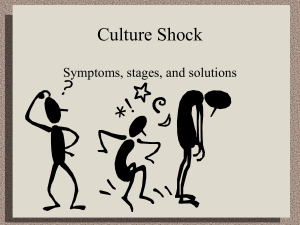
FLUID AND HAEMODYNAMIC DERANGEMENTS 1. In normal haemostasis a. Factor V inhibits thrombosis b. Α-2 microglobulin is antithrombotic c. PGI2 favours platelet aggregation d. Platelet aggregation is inhibited by vWF e. tPA is responsible for prothrombotic events 2. normal endothelial cells decrease platelet aggregation by secreting a. interleukin -1 b. vWF c. prostacyclin d. factor V e. thromboplastin 3. Thrombosis is potentiated by all of the following except a. vWF deficiency b. protein S deficiency c. Antithrombin III deficiency d. Thrombotic thrombocytopenia e. Acute leukaemia 4. Acute compensatory mechanisms in shock include all except a. Baroreceptor reflex b. Reverse stress-relaxation of vascular smooth muscle c. The effects of increased aldosterone secretion d. Activation of renin-angiotensin system e. CNS ischaemic response 5. prothrombotic characteristic of endothelium include a. plasminogen activator b. prostacyclin c. vWF d. thrombomodulin e. heparin like molecules 6. Shock in burns patients is primarily due to a. Neurogenic factors b. Hypovolaemia c. Acute RBC haemolysis d. Myocardial depression factor e. All of the above 7. Mediators of septic shock include all of the following except a. IL6 b. C5a c. PAF d. Catecholamines e. TNF antibodies 8. Prothrombotic factors include all of the following except a. PAF b. vWF c. nitric oxide d. tissue factor e. tPA inhibitor 9. Regarding septic shock a. Endotoxin is the only cause b. Marked vasoconstriction occurs in the non-infected tissue c. Cardiac output is as low as 75% in some places d. Endotoxin entering the circulation causes an effect very similar to anaphylaxis e. Blood viscosity is unchanged 10. Thrombus formation is inhibited by a. vWF b. IL-1 c. α2 macroglobulin d. TNF e. Endothelial cell injury 11. Oedema can be caused by a. Raised capillary hydrostatic pressure b. Reduced colloid osmotic pressure c. Vitamin C deficiency d. Elevated angiotensin II levels e. All of the above 12. The process of blood coagulation involves a. Prothrombin activator converting fibrinogen to fibrin b. The removal of peptides from each fibrinogen molecule c. The action of plasmin on fibrin d. α2 macroglobulin e. the action of ATIII to promote clotting 13. The first vascular response to injury is a. Slowing of the circulation b. Arteriolar vasoconstriction c. Capillary engorgement d. Recruitment of vascular beds e. Venular dilation 14. White infarcts occur in the a. Small intestines b. Kidney c. Lung d. Sigmoid colon e. Oesophagus 15. Air embolism a. Cannot occur in bone b. Affects only skeletal muscle and joints c. Causes focal ischaemia d. Is unlikely to occur with 10cc of air e. Is due to dissolved oxygen in divers 16. Oedema can be caused by a. Decreased hydrostatic pressure b. Sodium retention c. Hyperproteinaemia d. Polycythaemia e. Hypertension 17. regarding the types of shock a. cardiogenic shock is most commonly due to tamponade b. septic shock is caused by gram negative bacteria endotoxin in 70% cases c. anaphylactic shock is IgG mediated d. septic shock is caused by a low CO e. neurogenic shock can follow brachial plexus injury 18. tPA a. b. c. d. e. inactivates antithrombin is inactivated by thrombin converts plasminogen to thrombin is blocked by plasminogen activator is most effective when bound to fibrin meshwork 19. Regarding oedema a. Hypoproteinaemia is the commonest cause of systemic oedema b. Hepatic cirrhosis is the commonest cause of hypoproteinaemia c. Facial oedema is a prominent feature of anasarca d. Hereditary angioneurotic oedema involves skin only e. Infection does not cause pulmonary oedema 20. Concerning thrombosis which is false a. Endothelial injury can induce thrombosis b. Hypercoagulable states such as ATIII deficiency increases tendency to thrombosis c. Arterial thrombi contain Lines of Zahn d. Rheumatic fever predisposes arterial thrombi e. Thrombi are commonly seen in pancreatic or gastrointestinal carcinoma 21. Septic shock causes all except a. Myocardial depression b. Vasoconstriction c. DIC d. ARF e. ARDS 22. regarding infarction a. tumour obstruction accounts for a significant amount of cases b. all vascular occlusions lead to infarction c. they can be classified as either haemorrhagic or septic d. white infarcts occur in the testis e. most infarcts are wedge shaped 23. with regard to embolism a. arterial emboli most often lodge in viscera b. pulmonary emboli are rarely multiple c. amniotic fluid emboli are associated with the greatest percentage mortality d. most PEs produce clinical signs and symptoms of respiratory distress e. all emboli consist of either gas or solid intravascular mass 24. natural anticoagulants include a. vWF b. protein C c. protein P d. antithrombin IV e. TXA2 25. peripheral oedema a. is caused by decreased hydrostatic pressure b. is caused by increased renin-angiotensin-aldosterone secretion c. is characterized by a fluid with specific gravity of 1.020 d. is commonly caused by protein-losing gastroenteropathy e. is increased by salt restriction in the diet 26. With regard to amniotic fluid embolisation, which is false a. It can occur as a complication of labour b. There is lanugu hair in the pulmonary circulation c. Has a mortality of 70% d. DIC can occur e. It is characterized by severe dyspnoea, hypotensive shock and seizures 27. Infarction a. In tissues with a double circulation will be of the white type b. thromboembolic events accounts for 60% of the cause of all types of infarct c. usually has characteristic cytologic changes of liquefaction d. of anaemic type is initially darker than surrounding tissue e. of bland type is due to bacterial activity 28. With regard to shock a. There are 3 main types – cardiogenic, septic and anaphylactic b. Gram positive bacteria and fungi cannot induce septic shock c. Higher dose LPS directly injures endothelial cells, triggering coagulation cascade d. Superantigens are a major cause of septic shock e. Most young, healthy patients survive septic shock 29. In regard to coagulation a. The extrinsic and intrinsic pathways converge at the point where factor VII is activated b. The extrinsic and intrinsic pathways converge at the point where factor XII is activated c. The intrinsic pathway is activated in vitro d. The extrinsic pathway is activated in vitro by contact activation of Hageman factor e. Antithrombin is activated by the therapeutic administration of Vit K 30. concerning systemic thromboembolism a. the majority are secondary to MI b. aortic aneurysms are the commonest site of origin c. most end in the lungs d. deep leg veins are the commonest site of origin e. most end in the brain 31. With regards to oedema a. It is caused by increased interstitial osmotic pressure b. It results in gross cell swelling c. It is characterized by increased plasma volume d. Nephritic syndrome results in more severe oedema than cardiac dysfunction e. Outflow of fluid is from the venules 32. With regards to infarction a. The characteristic cytologic change of all infarcts is ischaemic coagulative necrosis of affected cells b. Is caused only by the occlusion of arterial supply c. Haemorrhagic infarcts are typically seen in solid tissues d. In most cases the necrotic focus is replaced with scar tissue e. Inflammatory exudates usually begins at the margins of an infarcted area within a few minutes 33. White infarcts a. May be transiently red b. Occur in the intestine c. Result from venous occlusion d. Are always septic e. Occur predominately in the liver 34. Which best defines the pathophysiology of shock a. Widespread tissue hypoxia as a result of decreased blood volume b. Lactic acid production c. Low CO d. Decreased blood volume e. Cellular hypoxia resulting from impaired tissue perfusion 35. regarding air embolism, what amount is required to produce symptoms a. 10ml b. 20ml c. 100ml d. 1000ml e. 1ml 36. post mortem features of a clot include a. lines of Zahn b. the absence of RBC in supernatant c. adherence to vascular walls 37. non-inflammatory oedema a. has a high protein content b. has a SG greater than 1.012 c. is caused by low levels of aldosterone d. is caused by elevated oncotic pressure e. is associated with elevated levels of ANP 38. DIC is associated with a. Thrombocytosis b. A bleeding diathesis presentation in a patient with malignancy 39. Fat embolism syndrome is associated with a. Mortality of >20% b. A non-thrombocytopenic petechial rash Answers 1. B 2. C 3. A 4. C 5. C 6. E 7. E 8. C 9. D 10. C 11. E 12. B 13. B 14. B 15. C 16. B 17. B 18. E 19. C 20. C 21. B 22. E 23. C 24. B 25. B 26. C 27. D 28. C 29. C 30. A 31. D 32. D 33. ? 34. E 35. C 36. B 37. E 38. B 39. B 40.




